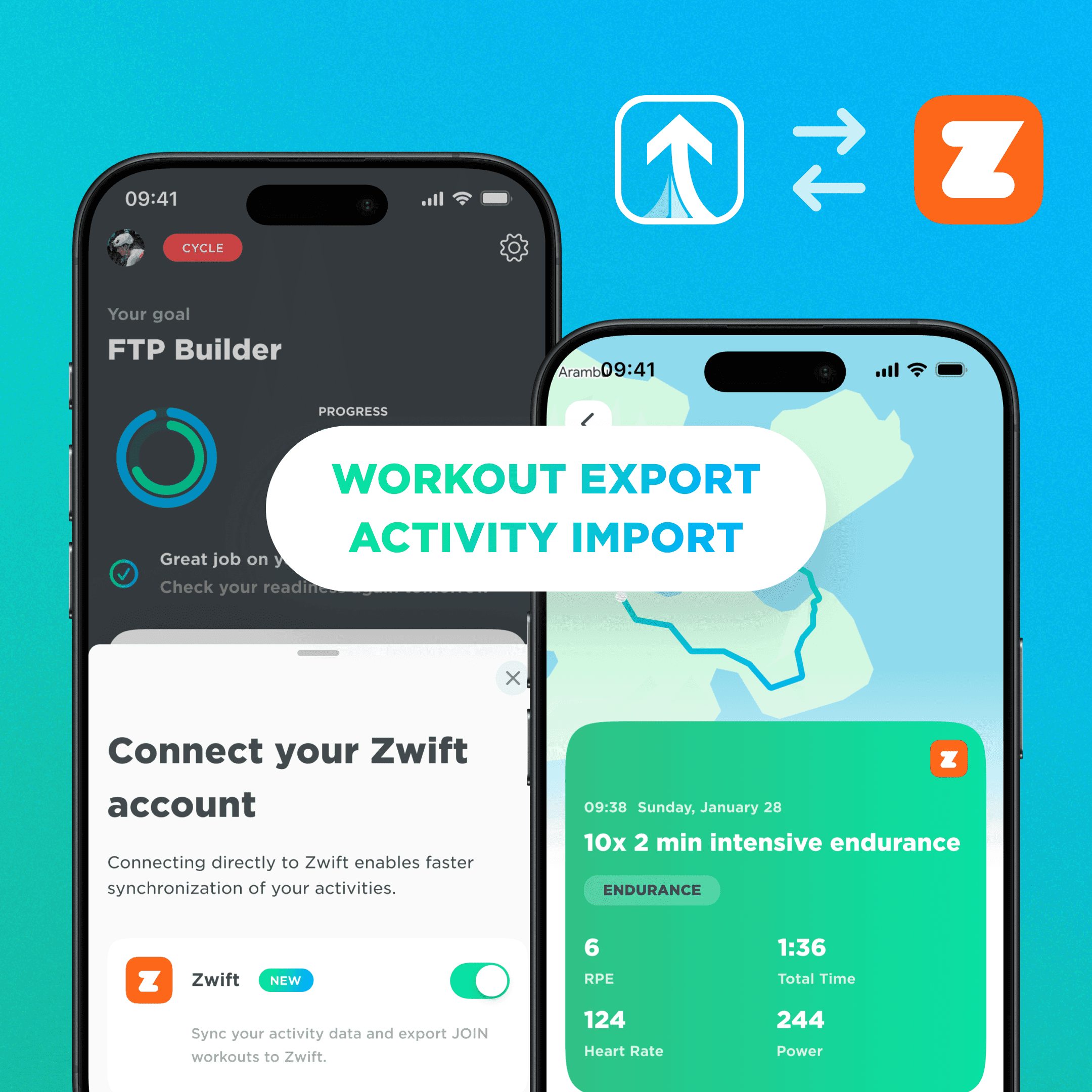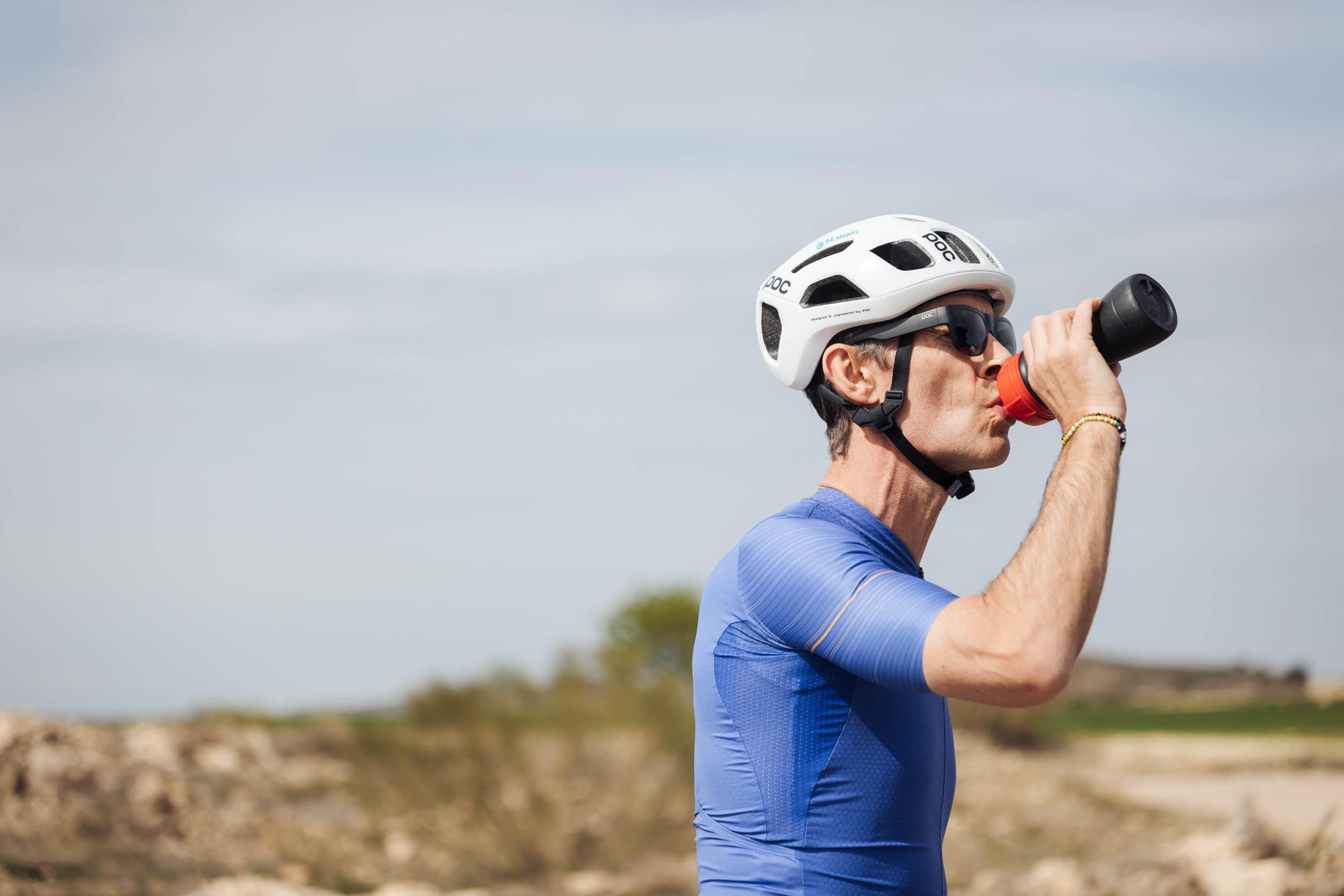Zone 2 cycling: Training plan, considerations, and definition

Nov 20, 2024
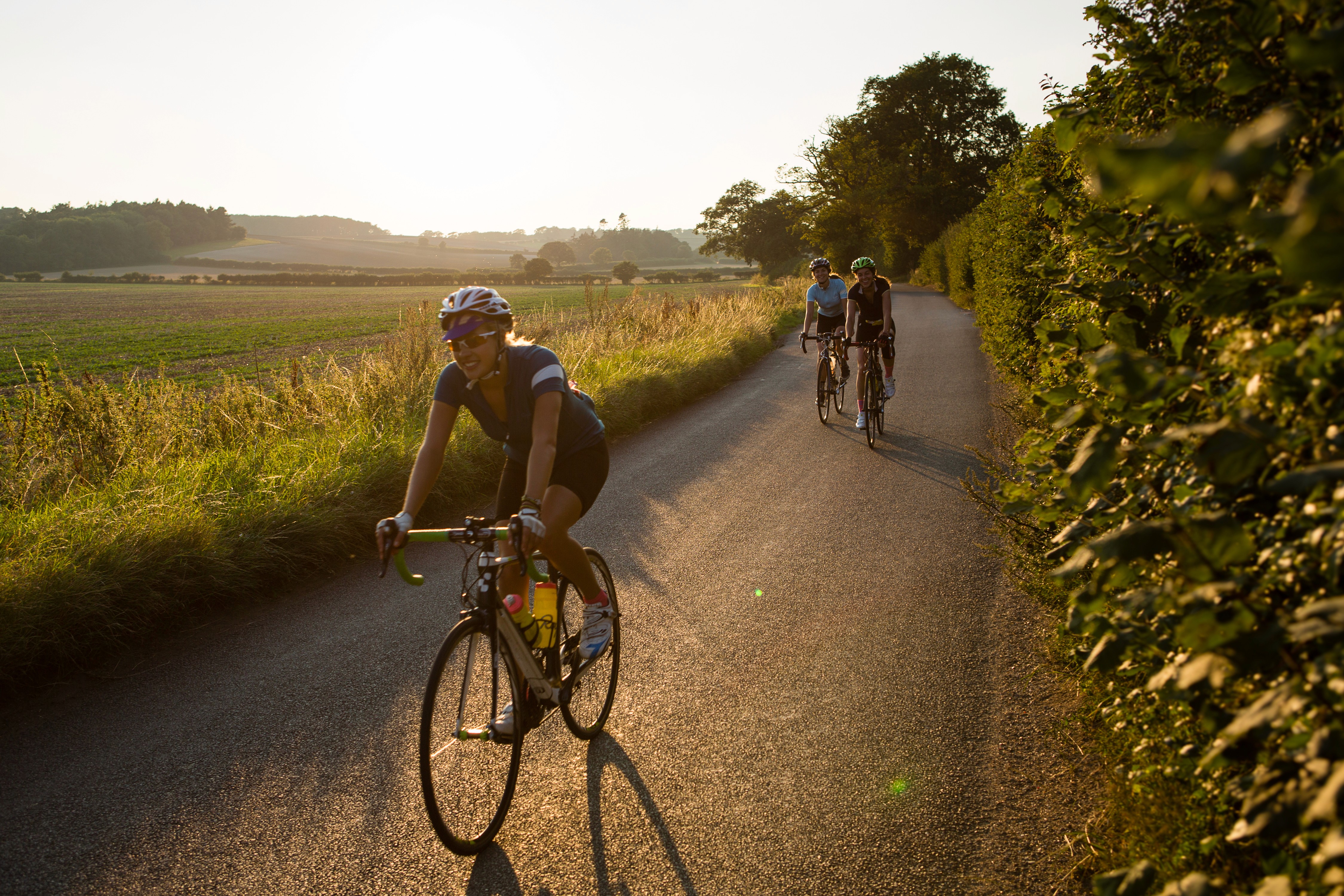
Zone 2 cycling: Training plan, considerations, and definition
Nov 20, 2024

Zone 2 cycling: Training plan, considerations, and definition

Nov 20, 2024

Zone 2 Cycling: Training Plan, Considerations, And Definition
When it comes to Zone 2 training, there are a ton of myths and misconceptions out there. In this ultimate Zone 2 training guide, the team here at JOIN has got together to provide you with everything you need to know about Zone 2 training. We've done the research and taken the guesswork out of it.
Regardless of whether you're a beginner to cycling who wants to get started or a lifelong cyclist looking to smash new goals, this guide will help you understand Zone 2 training and its importance for success.
Oh, and wait, that's not all; stay tuned until the end, when we'll introduce Zone 2 plan builder to help you kickstart your training journey.
What Is Zone 2 Cycling?
Zone 2 training involves cycling at a comfortable pace where you can easily hold a conversation. It’s important to note that Zone 2 is nothing new; in essence, Zone 2 is simply “endurance training” rebranded with a fancy new name and very clever marketing.
Even though it might seem odd, exercising at this lower intensity can actually be really good for you and offers a ton of physiological and psychological benefits.
The Endurance zone, also known as Zone 2, is when cyclists ride at a pace that's around 55/60% up until 75/80% of the threshold power. It's called "endurance" because it's a pace that you can keep up for the course of your entire ride. Of course, when a ride gets really long and/or the energy intake is not optimized, there will be some cardiac drift, but let’s not overcomplicate things for now. When it comes to calculating your zone 2, there really is no consensus, even among top sports scientists. For example, some take it as a percentage of your maximum heart rate, while others measure it by a percentage of threshold power or heart rate. Below, we've included an easy-to-read chart that can help you identify your zones.
When you ride in zone 2, your body primarily uses a type of muscle fiber that can continue for an extended period of time as long as you have enough fuel. Riding at this pace doesn't exhaust you too much, but it still helps your body get stronger and fitter, and most of all, zone 2 is sustainable for almost every rider regardless of their current fitness level.
Even though it's called "endurance," zone 2 riding isn't just for long, slow rides. You'll find yourself in the "endurance zone" during different kinds of rides and races, even including tough ones like criteriums. Zone 2 is an intensity that's used for recovery between tougher efforts and during longer, challenging workouts. So, no matter what kind of cycling you do, you'll be spending a lot of time in the Endurance zone.
Zone 2 And FTP
Zone 2, also known as the Endurance zone, is a level of cycling training that requires moderate, intense effort. It's not too intense, but it's not too easy either. This pace allows cyclists to continue riding without bonking too early or, hopefully, at all. Zone 2 training is ideal for all cyclists, from beginners to riders like Tadej Pogacar and Jonas Vingegaard.
Pushing the Limits Isn’t Always Better
Over the years, high-intensity interval training, or HIIT, has taken the sporting world by storm, with seemingly every so-called expert spruiking its benefits. While HIIT does provide great physiological benefits and should be included in every cyclist’s workout, the fact is most cyclists will greatly improve from increasing their time in zone 2.
Now, I know that seems counterintuitive, right? However, the fact is that training at lower intensities can significantly boost your overall and even maximal performance on the bike.
Without getting too technical, it’s important for you to note that each and every workout has what we call a “cost-to-ratio benefit:”
The Cost is the stress that your workout places on your body
The Benefit is the amount of fitness you achieve from having completed it.
For example, intervals provide you with significant benefits, but they also come at a great cost, which is why carefully planning your higher-intensity training is critical.
Alternatively, training in zone 2 provides you with just as many benefits as higher intensities but comes at much less cost. Because of this, Zone 2 training is much more sustainable over time.
Zone 2 And FTP: What’s the Connection?
The connection between zone 2 training and your FTP is most apparent at the cellular level. When you train for extended periods in zone 2, your muscles contract repeatedly, increasing their levels of calcium and activating what is known as the PGC-1a.
When this adaptation takes place, it leads to the creation of mitochondria, which are responsible for your aerobic metabolism. Simply put, the more new mitochondria you have, the greater chance of increasing your FTP.
While this path is activated in both the higher and lower intensities, the lower intensities should make up the majority of your training program due to their positive cost-to-ratio benefits. Remember, zone 2 training is less taxing on the body, therefore allowing you to train longer and more frequently.
Eight Benefits of Zone 2 Cycle Training
When it comes to Zone 2 training, there are benefits that can be observed physiologically. First and foremost, Zone 2 helps cyclists improve their ability to produce energy, which is obviously of great importance for cycling. Additionally, Zone 2 training also helps burn fat and improves the body's ability to clear lactate from the system.
Incorporating Zone 2 training into your cycling routine is crucial for enhancing your aerobic fitness levels. This type of training, which involves low-intensity endurance exercises, offers numerous benefits for cyclists.
Let's explore eight key advantages of Zone 2 training:
1. Improved Aerobic Efficiency
Engaging in Zone 2 training can lead to a significant improvement in your body's ability to effectively use fat as its main source of fuel. This increased capacity can result in improved energy levels and endurance, allowing you to sustain longer and more demanding hours in the saddle without the fear of bonking.
2. Develop Muscular Endurance
One of the main benefits when it comes to zone 2 training is its ability to develop slow-twitch muscles. Slow twitch muscles are generally associated with and benefit endurance sports such as cycling and running.
This is due to the fact these sports typically rely on the aerobic energy system. As your slow-twitch muscles become stronger, they're able to maintain higher power outputs for longer periods, prolonging fatigue and exhaustion and ultimately boosting your fitness.
3. Better Recovery
So, if you're, like most cyclists, you love going all out during training, so with that said, you're probably wondering how zone 2 training can actually help you recover. And won’t it set me back in my progress? The simple answer is NO.
Zone 2 training rides are the perfect training companion when it comes to balancing high-intensity interval rides or longer, more high-paced events like criteriums.
Including zone 2 training rides into your training program is an excellent way to recover and helps "set the stage" for significant improvements in:
Endurance
Power
Speed
Recovery and
Mental freshness.
Don't make the same mistake most cyclists make by neglecting their zone 2 training by going too hard too often. Take advantage of the vast array of JOIN endurance programs and boost your cycling performance today.
4. Improved Mitochondrial Function
Mitochondria are the powerhouses of our cells. They're responsible for developing the energy that our muscles need to function, and healthy mitochondria make a massive difference, especially in aspects of fitness like improved endurance and energy levels.
Aerobic (or cardio) sports like cycling, running, and swimming increase our heart rates and boost our body's ability to utilize oxygen. When performing zone 2 training and exercise, our mitochondria are forced to work harder to generate the energy our muscles are crying out for.
As with most things in life (sport being no exception), repetition over an extended period of time improves performance; this is precisely why zone 2 training makes up the majority of a pro cyclist training plan.
5. Improved Heart Health
Zone 2 training supports heart health by keeping your heart rate at a moderate rhythm, which safely boosts your endurance and efficiency.
Training and riding in Zone 2 can:
Burn fat
Keep your cells healthy
Lower your resting heart rate
Build endurance and
Lower your blood pressure.
Adding Zone 2 workouts to your cycling program not only improves your performance on the saddle but, more importantly, helps strengthen your heart and supports overall cardiovascular health. Now that's a win-win.
6. Improved Lactate Threshold
Training in Zone 2 can help your body get better at using lactate as a source of energy during longer and more intense workouts. This happens because it helps develop your slow-twitch muscles, increases the number of cells that produce energy, and improves your body's ability to utilize lactate.
7. Sustainable Training
At some point in time, most cyclists (myself included) have had periods of time when our training has simply become unsustainable. If this sounds like you, it's probably about time you gave Zone 2 training a go. One of the multiple benefits when it comes to Zone 2 training is just how sustainable it is.
While training in zones 3,4, and 5, your heart gets pushed to the limit, but when riding in zone 2, your heart rate stays at a moderate and sustainable intensity, meaning you can not only ride longer, but you can ride more.
8. Mental Toughness
Regardless of your cycling level, one of the most overlooked characteristics of our sport is mental toughness. Yes, even some of the pros struggle with this aspect of cycling and, as a result, fail to realize their full potential.
Zone 2 helps improve your mental toughness because, quite frankly, staying disciplined enough to remain in zone 2 is not as easy as it sounds. There's always the desire to get out of the saddle and smash the climb, but being committed to zone 2 means you need to resist the urge.
In the long run, this improved discipline will cross over to all areas of your cycling and life, making you a mentally tougher rider and person.
How To Calculate Your Zone 2
As you increase your effort, two key metrics become apparent: the aerobic threshold, where your body is at it’s maximal r fat-burning capacity, and the anaerobic threshold, where your body can't clear lactate at the same rate it produces.
By identifying these metrics, you can set up your training zones. The chart below provides you with a simple yet effective method of finding your zone 2.
<style>
.table_component {overflow:auto;width:100%;} .table_component table {border:1px solid #dededf;height:100%;width:100%;table-layout:auto;border-collapse:collapse;border-spacing:1px;text-align:left;} .table_component caption {caption-side:top;text-align:left;} .table_component th {border:1px solid #dededf;background-color:#eceff1;color:#000000;padding:5px;} .table_component td {border:1px solid #dededf;padding:5px;} .table_component tr:nth-child(even) td {background-color:#ffffff;color:#000000;} .table_component tr:nth-child(odd) td {background-color:#ffffff;color:#000000;}
</style>
<div class="table_component" role="region" tabindex="0"><table><caption>Table 1</caption><thead><tr><th>RPE</th><th>COLOR</th><th>HR % OF THRESHOLD</th><th>POWER % OF THRESHOLD</th><th>FEELING</th></tr></thead><tbody><tr><td>2-3</td><td>GREY</td><td>60-70%</td><td>50-59</td><td><p><b>Light</b> - Feels like you can maintain this pace for hours. Easy breathing and ability to carry out a conversation.</p></td></tr><tr><td>4-6</td><td>BLUE</td><td>71-80%</td><td>60-80</td><td><p><b>Moderate </b>- Feels like you can continue for hours. Breathing more heavily, but can still hold a (short)</p><p>conversation.</p></td></tr><tr><td>7-8</td><td>GREEN</td><td>81-90%</td><td>81-90</td><td><p><b>Vigorous </b>- Close to becoming uncomfortable. Short of breath, can speak only a sentence.</p></td></tr><tr><td>9</td><td>YELLOW</td><td>91-100%</td><td>91-105</td><td><p><b>Very Hard</b> - Very difficult to maintain exercise intensity. Breathing very hard and can only speak a single word.</p></td></tr><tr><td>10</td><td>RED</td><td>101% - MAX</td><td>105 - MAX</td><td><p><b>Maximum effort</b> - Feels almost impossible to keep going. Completely out of breath, unable to talk.</p></td></tr></tbody></table>
How Much Time To Spend in Zone 2
The answer to this question varies depending on which coach you ask, but a consistent number seems to be anywhere between 70% and 80% of your training time should be spent in Zone 2. Depending on how fit you are, these rides can last from 1 hour to 5 hours. Remember, though, not to overdo it. Too much of anything is never a good idea.
Building a Zone 2 Training Plan
When it comes to cycling and Zone 2 training, there are many misconceptions and misunderstandings out there. In this day and age, every man and his dog is an "expert."
The funny thing is that most cyclists are spending the majority of their time in the saddle in Zone 2 without even knowing it. As we know, zone 2 has some excellent physiologial benefits so with that said, let's delve deeper into how you can go about improving your zone 2 capacity.
Metabolic Flexibility
Endurance training, also known as Zone 2, is all about being able to keep riding for longer periods rather than going faster. To do this, your body needs to be able to burn fat efficiently. At low intensity, your body uses fat as a source of energy, but as the intensity increases, it starts burning more carbohydrates.
Since the supply of carbohydrates in your body is limited, it's important to train your body to use fat as a primary source of energy for long rides.
Prepping for Longer Rides
You can improve your fat-burning ability by slowly increasing the duration of your training sessions and by training at an intensity where fat-burning is at its highest, known as the aerobic threshold.
When training at this threshold, your body switches to primarily using fat as its main source of fuel. On the other hand, training just below this threshold is an excellent way to boost your endurance.
When building up your zone 2 endurance, it's important to start by increasing the duration of your rides at a comfortable, low intensity. You can also gradually add short periods of higher intensity, called tempo blocks, to increase your fat burning while also improving your overall speed.
The coaches at JOIN recommend focusing on increasing your duration at low intensity first before adding these "tempo blocks."
Dos And Don'ts for Endurance Training
For your long rides, depending on your schedule, we recommend doing at least one per week, but the length of these rides depends on the length of the upcoming events you may be targeting.
For example, if your target event is around 4-5 hours, one long ride a week of at least 4 hours should be sufficient.
When it comes to preparing for longer events, we highly recommend against making your longer rides too long, as this can negatively impact your upcoming training block and hinder your rest and recovery. Rather, we recommend doing a longer ride (5-6 hours) once a month and keeping the other weekly long rides to around 3-4 hours.
This approach is a safer and more conservative way to prepare for your upcoming event, providing you with an excellent base of zone 2 training without overdoing it and compromising your recovery.
Five Endurance Workouts With JOIN
When it comes to boosting your riding experience and zone 2 training, the team here at JOIN has got you covered. Simply choose from more than 80 structured training plans that have been specifically designed to help you not only achieve your Zone 2 training goals but also smash them.
1. 4hr Intensive Endurance
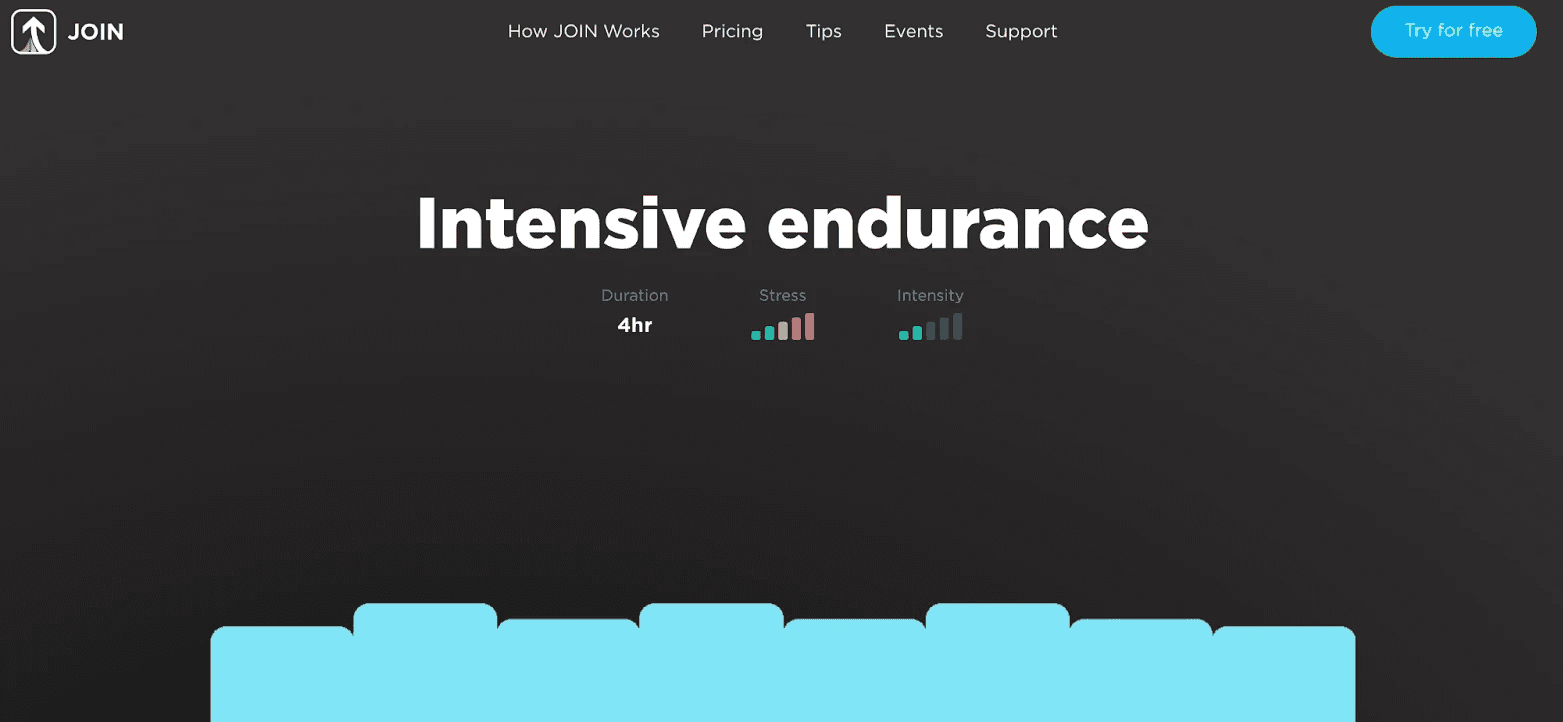
The 4-hour Intensive Endurance workout consists of alternating intervals of 30 minutes, providing you, the rider, with both high and low-intensity segments within the endurance zone. The coaches here at JOIN highly recommend maintaining a cadence of around 90 RPM throughout the duration of the workout, including changes in intensity.
This workout is developed to feel fairly easy. As the workout intensity slightly rises, focus on increasing your cadence without bouncing out of the saddle.
2. 20x 2-minute Intensive Endurance Intervals
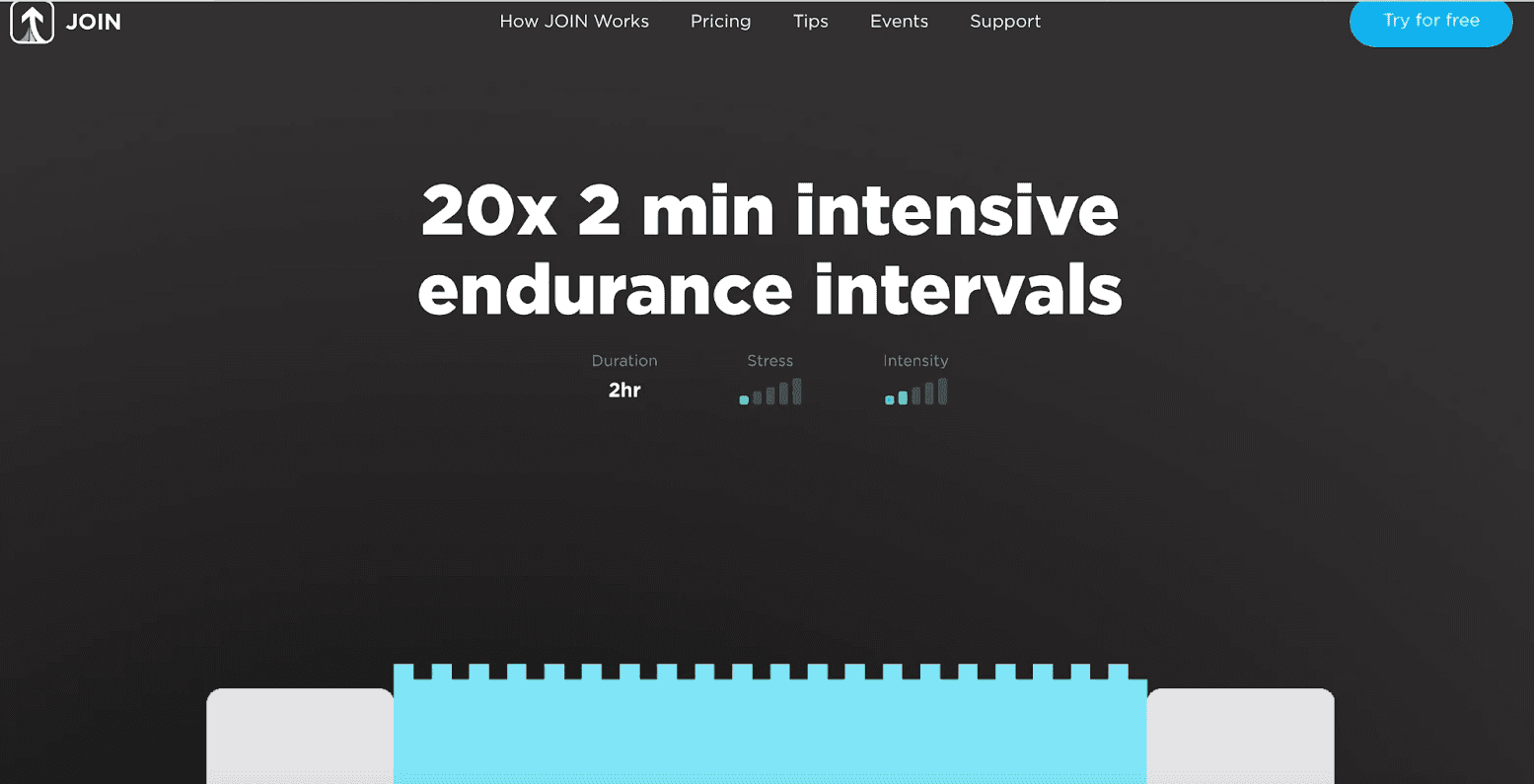
In this 2-hour workout, you will be alternating between 2-minute intensive endurance intervals. During these intervals, your heart rate, power, and rate of perceived exertion (RPE) will increase slightly, but they should remain firmly in the endurance zone.
This workout is designed to be relatively easy and varied, so it shouldn't feel too challenging. Aim to maintain a cadence above 85 rpm throughout the workout.
3. 12x 4-minute Intensive Endurance Intervals

In this 2-hour and 30-minute workout, you'll be switching between 4 minutes of intensive endurance intervals. Your heart rate, power, and rate of perceived exertion (RPE) will slightly increase but should remain in the endurance zone, otherwise known as zone 2.
This workout is designed to be relatively easy and shouldn't be too tough to handle. The coaches at JOIN highly recommend keeping your cadence between 85 and 90 rpm, particularly during the changes in intensity.
4. 1hr And 30 Minute Easy Endurance
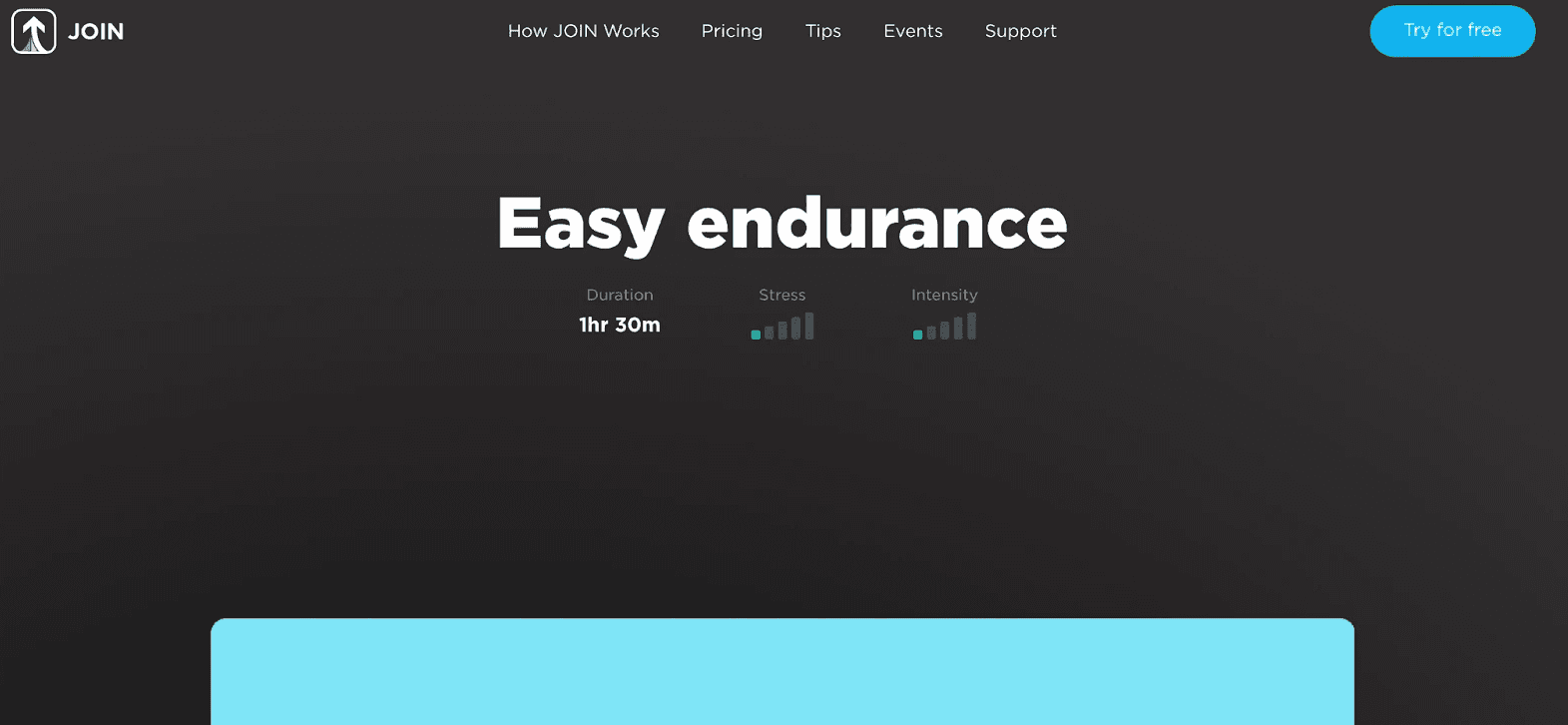
Want the most bang for your buck? Crunched for time? You can do just that with only 1.5 hours of relaxed, steady-state exercise in this workout designed by JOIN.
The beauty of this ride is that it gives you options. Want to ride outside and solo? No problem. Want to complete the workout on your indoor trainer? Easy done. Maybe you'd prefer riding in the bunch with your mates?
This workout provides it all. Just remember to keep your cadence between 85 and 90 RPM and focus on pacing yourself for the duration of the ride while leaving enough energy in the tank to feel like you could do it all again.
5. 10x 2-Minute Intensive Endurance
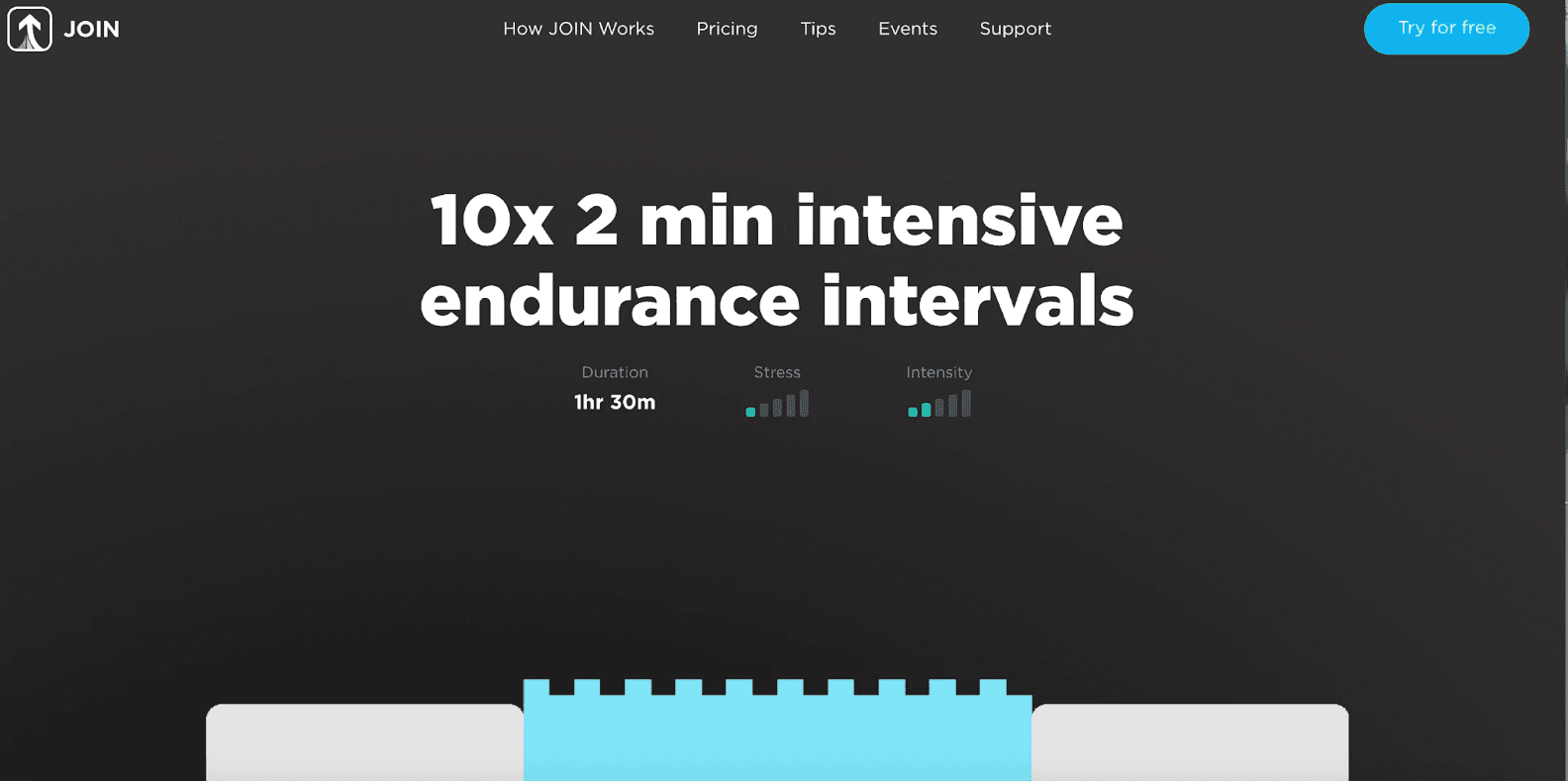
The 10x two-minute workout lasts for 90 minutes, where you'll be performing 2 minutes of alternating intensive endurance intervals. During these intervals, your main priority should be to slightly increase your heart rate, power output, and rate of perceived exertion (RPE) while still staying within the endurance zone.
Unlike some of the other workouts, the 10x two-minute workout should feel challenging but not to the point where you’ll feel like you can't complete it. Remember, in these types of endurance and zone 2 workouts, you should feel like you've always got plenty of gas left in the tank.
Maintain a cadence of over 85 rpm throughout the duration of the workout and when performing the intervals.
Summary of Training in Zone 2
In summary, let’s just take a quick look to recap some of the do’s and dont’s when it comes to endurance training.
Do’s
Ensure you’re adequately fueled for your Zone 2 rides
Spend between 70-80% of your training time in Zone 2
Weigh up the cost-to-benefit ratio of each training session
Keep your cadence between 85-90 RPM while performing Zone 2
Gradually increase the amount of time you train in Zone 2
Don'ts
Do not perform endurance training when you’re under fuelled.
Do not schedule more than two longer rides each week
Do not go overboard training in Zone 3 and 4
Dynamic Zone 2 Workouts That Adjust to Your Schedule
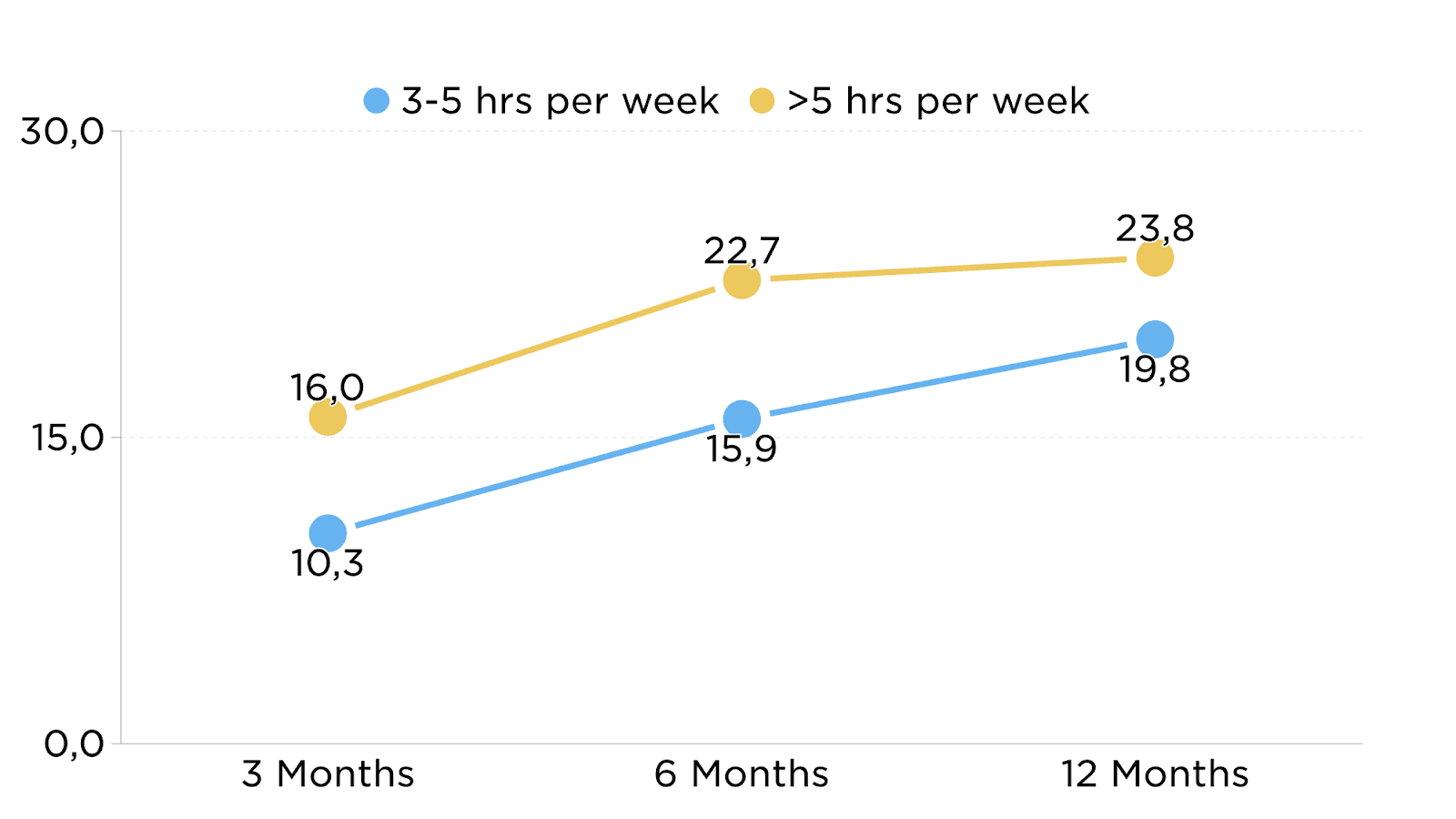
Ready to take your cycling to the next level? Join's highly adaptive training program, is designed to help you boost your cycling performance.
Our users have reported that they are not only riding longer and faster but stronger, too. With JOIN, you can work out whenever your schedule permits, and the best part is that the program adjusts to fit your timetable and current fitness level.
Start now with a free trial to see how Join can elevate your cycling performance. Improve your FTP by 23.8 watts within 12 months.
Join now and smash your cycling goals!
Zone 2 Cycling: Training Plan, Considerations, And Definition
When it comes to Zone 2 training, there are a ton of myths and misconceptions out there. In this ultimate Zone 2 training guide, the team here at JOIN has got together to provide you with everything you need to know about Zone 2 training. We've done the research and taken the guesswork out of it.
Regardless of whether you're a beginner to cycling who wants to get started or a lifelong cyclist looking to smash new goals, this guide will help you understand Zone 2 training and its importance for success.
Oh, and wait, that's not all; stay tuned until the end, when we'll introduce Zone 2 plan builder to help you kickstart your training journey.
What Is Zone 2 Cycling?
Zone 2 training involves cycling at a comfortable pace where you can easily hold a conversation. It’s important to note that Zone 2 is nothing new; in essence, Zone 2 is simply “endurance training” rebranded with a fancy new name and very clever marketing.
Even though it might seem odd, exercising at this lower intensity can actually be really good for you and offers a ton of physiological and psychological benefits.
The Endurance zone, also known as Zone 2, is when cyclists ride at a pace that's around 55/60% up until 75/80% of the threshold power. It's called "endurance" because it's a pace that you can keep up for the course of your entire ride. Of course, when a ride gets really long and/or the energy intake is not optimized, there will be some cardiac drift, but let’s not overcomplicate things for now. When it comes to calculating your zone 2, there really is no consensus, even among top sports scientists. For example, some take it as a percentage of your maximum heart rate, while others measure it by a percentage of threshold power or heart rate. Below, we've included an easy-to-read chart that can help you identify your zones.
When you ride in zone 2, your body primarily uses a type of muscle fiber that can continue for an extended period of time as long as you have enough fuel. Riding at this pace doesn't exhaust you too much, but it still helps your body get stronger and fitter, and most of all, zone 2 is sustainable for almost every rider regardless of their current fitness level.
Even though it's called "endurance," zone 2 riding isn't just for long, slow rides. You'll find yourself in the "endurance zone" during different kinds of rides and races, even including tough ones like criteriums. Zone 2 is an intensity that's used for recovery between tougher efforts and during longer, challenging workouts. So, no matter what kind of cycling you do, you'll be spending a lot of time in the Endurance zone.
Zone 2 And FTP
Zone 2, also known as the Endurance zone, is a level of cycling training that requires moderate, intense effort. It's not too intense, but it's not too easy either. This pace allows cyclists to continue riding without bonking too early or, hopefully, at all. Zone 2 training is ideal for all cyclists, from beginners to riders like Tadej Pogacar and Jonas Vingegaard.
Pushing the Limits Isn’t Always Better
Over the years, high-intensity interval training, or HIIT, has taken the sporting world by storm, with seemingly every so-called expert spruiking its benefits. While HIIT does provide great physiological benefits and should be included in every cyclist’s workout, the fact is most cyclists will greatly improve from increasing their time in zone 2.
Now, I know that seems counterintuitive, right? However, the fact is that training at lower intensities can significantly boost your overall and even maximal performance on the bike.
Without getting too technical, it’s important for you to note that each and every workout has what we call a “cost-to-ratio benefit:”
The Cost is the stress that your workout places on your body
The Benefit is the amount of fitness you achieve from having completed it.
For example, intervals provide you with significant benefits, but they also come at a great cost, which is why carefully planning your higher-intensity training is critical.
Alternatively, training in zone 2 provides you with just as many benefits as higher intensities but comes at much less cost. Because of this, Zone 2 training is much more sustainable over time.
Zone 2 And FTP: What’s the Connection?
The connection between zone 2 training and your FTP is most apparent at the cellular level. When you train for extended periods in zone 2, your muscles contract repeatedly, increasing their levels of calcium and activating what is known as the PGC-1a.
When this adaptation takes place, it leads to the creation of mitochondria, which are responsible for your aerobic metabolism. Simply put, the more new mitochondria you have, the greater chance of increasing your FTP.
While this path is activated in both the higher and lower intensities, the lower intensities should make up the majority of your training program due to their positive cost-to-ratio benefits. Remember, zone 2 training is less taxing on the body, therefore allowing you to train longer and more frequently.
Eight Benefits of Zone 2 Cycle Training
When it comes to Zone 2 training, there are benefits that can be observed physiologically. First and foremost, Zone 2 helps cyclists improve their ability to produce energy, which is obviously of great importance for cycling. Additionally, Zone 2 training also helps burn fat and improves the body's ability to clear lactate from the system.
Incorporating Zone 2 training into your cycling routine is crucial for enhancing your aerobic fitness levels. This type of training, which involves low-intensity endurance exercises, offers numerous benefits for cyclists.
Let's explore eight key advantages of Zone 2 training:
1. Improved Aerobic Efficiency
Engaging in Zone 2 training can lead to a significant improvement in your body's ability to effectively use fat as its main source of fuel. This increased capacity can result in improved energy levels and endurance, allowing you to sustain longer and more demanding hours in the saddle without the fear of bonking.
2. Develop Muscular Endurance
One of the main benefits when it comes to zone 2 training is its ability to develop slow-twitch muscles. Slow twitch muscles are generally associated with and benefit endurance sports such as cycling and running.
This is due to the fact these sports typically rely on the aerobic energy system. As your slow-twitch muscles become stronger, they're able to maintain higher power outputs for longer periods, prolonging fatigue and exhaustion and ultimately boosting your fitness.
3. Better Recovery
So, if you're, like most cyclists, you love going all out during training, so with that said, you're probably wondering how zone 2 training can actually help you recover. And won’t it set me back in my progress? The simple answer is NO.
Zone 2 training rides are the perfect training companion when it comes to balancing high-intensity interval rides or longer, more high-paced events like criteriums.
Including zone 2 training rides into your training program is an excellent way to recover and helps "set the stage" for significant improvements in:
Endurance
Power
Speed
Recovery and
Mental freshness.
Don't make the same mistake most cyclists make by neglecting their zone 2 training by going too hard too often. Take advantage of the vast array of JOIN endurance programs and boost your cycling performance today.
4. Improved Mitochondrial Function
Mitochondria are the powerhouses of our cells. They're responsible for developing the energy that our muscles need to function, and healthy mitochondria make a massive difference, especially in aspects of fitness like improved endurance and energy levels.
Aerobic (or cardio) sports like cycling, running, and swimming increase our heart rates and boost our body's ability to utilize oxygen. When performing zone 2 training and exercise, our mitochondria are forced to work harder to generate the energy our muscles are crying out for.
As with most things in life (sport being no exception), repetition over an extended period of time improves performance; this is precisely why zone 2 training makes up the majority of a pro cyclist training plan.
5. Improved Heart Health
Zone 2 training supports heart health by keeping your heart rate at a moderate rhythm, which safely boosts your endurance and efficiency.
Training and riding in Zone 2 can:
Burn fat
Keep your cells healthy
Lower your resting heart rate
Build endurance and
Lower your blood pressure.
Adding Zone 2 workouts to your cycling program not only improves your performance on the saddle but, more importantly, helps strengthen your heart and supports overall cardiovascular health. Now that's a win-win.
6. Improved Lactate Threshold
Training in Zone 2 can help your body get better at using lactate as a source of energy during longer and more intense workouts. This happens because it helps develop your slow-twitch muscles, increases the number of cells that produce energy, and improves your body's ability to utilize lactate.
7. Sustainable Training
At some point in time, most cyclists (myself included) have had periods of time when our training has simply become unsustainable. If this sounds like you, it's probably about time you gave Zone 2 training a go. One of the multiple benefits when it comes to Zone 2 training is just how sustainable it is.
While training in zones 3,4, and 5, your heart gets pushed to the limit, but when riding in zone 2, your heart rate stays at a moderate and sustainable intensity, meaning you can not only ride longer, but you can ride more.
8. Mental Toughness
Regardless of your cycling level, one of the most overlooked characteristics of our sport is mental toughness. Yes, even some of the pros struggle with this aspect of cycling and, as a result, fail to realize their full potential.
Zone 2 helps improve your mental toughness because, quite frankly, staying disciplined enough to remain in zone 2 is not as easy as it sounds. There's always the desire to get out of the saddle and smash the climb, but being committed to zone 2 means you need to resist the urge.
In the long run, this improved discipline will cross over to all areas of your cycling and life, making you a mentally tougher rider and person.
How To Calculate Your Zone 2
As you increase your effort, two key metrics become apparent: the aerobic threshold, where your body is at it’s maximal r fat-burning capacity, and the anaerobic threshold, where your body can't clear lactate at the same rate it produces.
By identifying these metrics, you can set up your training zones. The chart below provides you with a simple yet effective method of finding your zone 2.
<style>
.table_component {overflow:auto;width:100%;} .table_component table {border:1px solid #dededf;height:100%;width:100%;table-layout:auto;border-collapse:collapse;border-spacing:1px;text-align:left;} .table_component caption {caption-side:top;text-align:left;} .table_component th {border:1px solid #dededf;background-color:#eceff1;color:#000000;padding:5px;} .table_component td {border:1px solid #dededf;padding:5px;} .table_component tr:nth-child(even) td {background-color:#ffffff;color:#000000;} .table_component tr:nth-child(odd) td {background-color:#ffffff;color:#000000;}
</style>
<div class="table_component" role="region" tabindex="0"><table><caption>Table 1</caption><thead><tr><th>RPE</th><th>COLOR</th><th>HR % OF THRESHOLD</th><th>POWER % OF THRESHOLD</th><th>FEELING</th></tr></thead><tbody><tr><td>2-3</td><td>GREY</td><td>60-70%</td><td>50-59</td><td><p><b>Light</b> - Feels like you can maintain this pace for hours. Easy breathing and ability to carry out a conversation.</p></td></tr><tr><td>4-6</td><td>BLUE</td><td>71-80%</td><td>60-80</td><td><p><b>Moderate </b>- Feels like you can continue for hours. Breathing more heavily, but can still hold a (short)</p><p>conversation.</p></td></tr><tr><td>7-8</td><td>GREEN</td><td>81-90%</td><td>81-90</td><td><p><b>Vigorous </b>- Close to becoming uncomfortable. Short of breath, can speak only a sentence.</p></td></tr><tr><td>9</td><td>YELLOW</td><td>91-100%</td><td>91-105</td><td><p><b>Very Hard</b> - Very difficult to maintain exercise intensity. Breathing very hard and can only speak a single word.</p></td></tr><tr><td>10</td><td>RED</td><td>101% - MAX</td><td>105 - MAX</td><td><p><b>Maximum effort</b> - Feels almost impossible to keep going. Completely out of breath, unable to talk.</p></td></tr></tbody></table>
How Much Time To Spend in Zone 2
The answer to this question varies depending on which coach you ask, but a consistent number seems to be anywhere between 70% and 80% of your training time should be spent in Zone 2. Depending on how fit you are, these rides can last from 1 hour to 5 hours. Remember, though, not to overdo it. Too much of anything is never a good idea.
Building a Zone 2 Training Plan
When it comes to cycling and Zone 2 training, there are many misconceptions and misunderstandings out there. In this day and age, every man and his dog is an "expert."
The funny thing is that most cyclists are spending the majority of their time in the saddle in Zone 2 without even knowing it. As we know, zone 2 has some excellent physiologial benefits so with that said, let's delve deeper into how you can go about improving your zone 2 capacity.
Metabolic Flexibility
Endurance training, also known as Zone 2, is all about being able to keep riding for longer periods rather than going faster. To do this, your body needs to be able to burn fat efficiently. At low intensity, your body uses fat as a source of energy, but as the intensity increases, it starts burning more carbohydrates.
Since the supply of carbohydrates in your body is limited, it's important to train your body to use fat as a primary source of energy for long rides.
Prepping for Longer Rides
You can improve your fat-burning ability by slowly increasing the duration of your training sessions and by training at an intensity where fat-burning is at its highest, known as the aerobic threshold.
When training at this threshold, your body switches to primarily using fat as its main source of fuel. On the other hand, training just below this threshold is an excellent way to boost your endurance.
When building up your zone 2 endurance, it's important to start by increasing the duration of your rides at a comfortable, low intensity. You can also gradually add short periods of higher intensity, called tempo blocks, to increase your fat burning while also improving your overall speed.
The coaches at JOIN recommend focusing on increasing your duration at low intensity first before adding these "tempo blocks."
Dos And Don'ts for Endurance Training
For your long rides, depending on your schedule, we recommend doing at least one per week, but the length of these rides depends on the length of the upcoming events you may be targeting.
For example, if your target event is around 4-5 hours, one long ride a week of at least 4 hours should be sufficient.
When it comes to preparing for longer events, we highly recommend against making your longer rides too long, as this can negatively impact your upcoming training block and hinder your rest and recovery. Rather, we recommend doing a longer ride (5-6 hours) once a month and keeping the other weekly long rides to around 3-4 hours.
This approach is a safer and more conservative way to prepare for your upcoming event, providing you with an excellent base of zone 2 training without overdoing it and compromising your recovery.
Five Endurance Workouts With JOIN
When it comes to boosting your riding experience and zone 2 training, the team here at JOIN has got you covered. Simply choose from more than 80 structured training plans that have been specifically designed to help you not only achieve your Zone 2 training goals but also smash them.
1. 4hr Intensive Endurance

The 4-hour Intensive Endurance workout consists of alternating intervals of 30 minutes, providing you, the rider, with both high and low-intensity segments within the endurance zone. The coaches here at JOIN highly recommend maintaining a cadence of around 90 RPM throughout the duration of the workout, including changes in intensity.
This workout is developed to feel fairly easy. As the workout intensity slightly rises, focus on increasing your cadence without bouncing out of the saddle.
2. 20x 2-minute Intensive Endurance Intervals

In this 2-hour workout, you will be alternating between 2-minute intensive endurance intervals. During these intervals, your heart rate, power, and rate of perceived exertion (RPE) will increase slightly, but they should remain firmly in the endurance zone.
This workout is designed to be relatively easy and varied, so it shouldn't feel too challenging. Aim to maintain a cadence above 85 rpm throughout the workout.
3. 12x 4-minute Intensive Endurance Intervals

In this 2-hour and 30-minute workout, you'll be switching between 4 minutes of intensive endurance intervals. Your heart rate, power, and rate of perceived exertion (RPE) will slightly increase but should remain in the endurance zone, otherwise known as zone 2.
This workout is designed to be relatively easy and shouldn't be too tough to handle. The coaches at JOIN highly recommend keeping your cadence between 85 and 90 rpm, particularly during the changes in intensity.
4. 1hr And 30 Minute Easy Endurance

Want the most bang for your buck? Crunched for time? You can do just that with only 1.5 hours of relaxed, steady-state exercise in this workout designed by JOIN.
The beauty of this ride is that it gives you options. Want to ride outside and solo? No problem. Want to complete the workout on your indoor trainer? Easy done. Maybe you'd prefer riding in the bunch with your mates?
This workout provides it all. Just remember to keep your cadence between 85 and 90 RPM and focus on pacing yourself for the duration of the ride while leaving enough energy in the tank to feel like you could do it all again.
5. 10x 2-Minute Intensive Endurance

The 10x two-minute workout lasts for 90 minutes, where you'll be performing 2 minutes of alternating intensive endurance intervals. During these intervals, your main priority should be to slightly increase your heart rate, power output, and rate of perceived exertion (RPE) while still staying within the endurance zone.
Unlike some of the other workouts, the 10x two-minute workout should feel challenging but not to the point where you’ll feel like you can't complete it. Remember, in these types of endurance and zone 2 workouts, you should feel like you've always got plenty of gas left in the tank.
Maintain a cadence of over 85 rpm throughout the duration of the workout and when performing the intervals.
Summary of Training in Zone 2
In summary, let’s just take a quick look to recap some of the do’s and dont’s when it comes to endurance training.
Do’s
Ensure you’re adequately fueled for your Zone 2 rides
Spend between 70-80% of your training time in Zone 2
Weigh up the cost-to-benefit ratio of each training session
Keep your cadence between 85-90 RPM while performing Zone 2
Gradually increase the amount of time you train in Zone 2
Don'ts
Do not perform endurance training when you’re under fuelled.
Do not schedule more than two longer rides each week
Do not go overboard training in Zone 3 and 4
Dynamic Zone 2 Workouts That Adjust to Your Schedule

Ready to take your cycling to the next level? Join's highly adaptive training program, is designed to help you boost your cycling performance.
Our users have reported that they are not only riding longer and faster but stronger, too. With JOIN, you can work out whenever your schedule permits, and the best part is that the program adjusts to fit your timetable and current fitness level.
Start now with a free trial to see how Join can elevate your cycling performance. Improve your FTP by 23.8 watts within 12 months.
Join now and smash your cycling goals!
Zone 2 Cycling: Training Plan, Considerations, And Definition
When it comes to Zone 2 training, there are a ton of myths and misconceptions out there. In this ultimate Zone 2 training guide, the team here at JOIN has got together to provide you with everything you need to know about Zone 2 training. We've done the research and taken the guesswork out of it.
Regardless of whether you're a beginner to cycling who wants to get started or a lifelong cyclist looking to smash new goals, this guide will help you understand Zone 2 training and its importance for success.
Oh, and wait, that's not all; stay tuned until the end, when we'll introduce Zone 2 plan builder to help you kickstart your training journey.
What Is Zone 2 Cycling?
Zone 2 training involves cycling at a comfortable pace where you can easily hold a conversation. It’s important to note that Zone 2 is nothing new; in essence, Zone 2 is simply “endurance training” rebranded with a fancy new name and very clever marketing.
Even though it might seem odd, exercising at this lower intensity can actually be really good for you and offers a ton of physiological and psychological benefits.
The Endurance zone, also known as Zone 2, is when cyclists ride at a pace that's around 55/60% up until 75/80% of the threshold power. It's called "endurance" because it's a pace that you can keep up for the course of your entire ride. Of course, when a ride gets really long and/or the energy intake is not optimized, there will be some cardiac drift, but let’s not overcomplicate things for now. When it comes to calculating your zone 2, there really is no consensus, even among top sports scientists. For example, some take it as a percentage of your maximum heart rate, while others measure it by a percentage of threshold power or heart rate. Below, we've included an easy-to-read chart that can help you identify your zones.
When you ride in zone 2, your body primarily uses a type of muscle fiber that can continue for an extended period of time as long as you have enough fuel. Riding at this pace doesn't exhaust you too much, but it still helps your body get stronger and fitter, and most of all, zone 2 is sustainable for almost every rider regardless of their current fitness level.
Even though it's called "endurance," zone 2 riding isn't just for long, slow rides. You'll find yourself in the "endurance zone" during different kinds of rides and races, even including tough ones like criteriums. Zone 2 is an intensity that's used for recovery between tougher efforts and during longer, challenging workouts. So, no matter what kind of cycling you do, you'll be spending a lot of time in the Endurance zone.
Zone 2 And FTP
Zone 2, also known as the Endurance zone, is a level of cycling training that requires moderate, intense effort. It's not too intense, but it's not too easy either. This pace allows cyclists to continue riding without bonking too early or, hopefully, at all. Zone 2 training is ideal for all cyclists, from beginners to riders like Tadej Pogacar and Jonas Vingegaard.
Pushing the Limits Isn’t Always Better
Over the years, high-intensity interval training, or HIIT, has taken the sporting world by storm, with seemingly every so-called expert spruiking its benefits. While HIIT does provide great physiological benefits and should be included in every cyclist’s workout, the fact is most cyclists will greatly improve from increasing their time in zone 2.
Now, I know that seems counterintuitive, right? However, the fact is that training at lower intensities can significantly boost your overall and even maximal performance on the bike.
Without getting too technical, it’s important for you to note that each and every workout has what we call a “cost-to-ratio benefit:”
The Cost is the stress that your workout places on your body
The Benefit is the amount of fitness you achieve from having completed it.
For example, intervals provide you with significant benefits, but they also come at a great cost, which is why carefully planning your higher-intensity training is critical.
Alternatively, training in zone 2 provides you with just as many benefits as higher intensities but comes at much less cost. Because of this, Zone 2 training is much more sustainable over time.
Zone 2 And FTP: What’s the Connection?
The connection between zone 2 training and your FTP is most apparent at the cellular level. When you train for extended periods in zone 2, your muscles contract repeatedly, increasing their levels of calcium and activating what is known as the PGC-1a.
When this adaptation takes place, it leads to the creation of mitochondria, which are responsible for your aerobic metabolism. Simply put, the more new mitochondria you have, the greater chance of increasing your FTP.
While this path is activated in both the higher and lower intensities, the lower intensities should make up the majority of your training program due to their positive cost-to-ratio benefits. Remember, zone 2 training is less taxing on the body, therefore allowing you to train longer and more frequently.
Eight Benefits of Zone 2 Cycle Training
When it comes to Zone 2 training, there are benefits that can be observed physiologically. First and foremost, Zone 2 helps cyclists improve their ability to produce energy, which is obviously of great importance for cycling. Additionally, Zone 2 training also helps burn fat and improves the body's ability to clear lactate from the system.
Incorporating Zone 2 training into your cycling routine is crucial for enhancing your aerobic fitness levels. This type of training, which involves low-intensity endurance exercises, offers numerous benefits for cyclists.
Let's explore eight key advantages of Zone 2 training:
1. Improved Aerobic Efficiency
Engaging in Zone 2 training can lead to a significant improvement in your body's ability to effectively use fat as its main source of fuel. This increased capacity can result in improved energy levels and endurance, allowing you to sustain longer and more demanding hours in the saddle without the fear of bonking.
2. Develop Muscular Endurance
One of the main benefits when it comes to zone 2 training is its ability to develop slow-twitch muscles. Slow twitch muscles are generally associated with and benefit endurance sports such as cycling and running.
This is due to the fact these sports typically rely on the aerobic energy system. As your slow-twitch muscles become stronger, they're able to maintain higher power outputs for longer periods, prolonging fatigue and exhaustion and ultimately boosting your fitness.
3. Better Recovery
So, if you're, like most cyclists, you love going all out during training, so with that said, you're probably wondering how zone 2 training can actually help you recover. And won’t it set me back in my progress? The simple answer is NO.
Zone 2 training rides are the perfect training companion when it comes to balancing high-intensity interval rides or longer, more high-paced events like criteriums.
Including zone 2 training rides into your training program is an excellent way to recover and helps "set the stage" for significant improvements in:
Endurance
Power
Speed
Recovery and
Mental freshness.
Don't make the same mistake most cyclists make by neglecting their zone 2 training by going too hard too often. Take advantage of the vast array of JOIN endurance programs and boost your cycling performance today.
4. Improved Mitochondrial Function
Mitochondria are the powerhouses of our cells. They're responsible for developing the energy that our muscles need to function, and healthy mitochondria make a massive difference, especially in aspects of fitness like improved endurance and energy levels.
Aerobic (or cardio) sports like cycling, running, and swimming increase our heart rates and boost our body's ability to utilize oxygen. When performing zone 2 training and exercise, our mitochondria are forced to work harder to generate the energy our muscles are crying out for.
As with most things in life (sport being no exception), repetition over an extended period of time improves performance; this is precisely why zone 2 training makes up the majority of a pro cyclist training plan.
5. Improved Heart Health
Zone 2 training supports heart health by keeping your heart rate at a moderate rhythm, which safely boosts your endurance and efficiency.
Training and riding in Zone 2 can:
Burn fat
Keep your cells healthy
Lower your resting heart rate
Build endurance and
Lower your blood pressure.
Adding Zone 2 workouts to your cycling program not only improves your performance on the saddle but, more importantly, helps strengthen your heart and supports overall cardiovascular health. Now that's a win-win.
6. Improved Lactate Threshold
Training in Zone 2 can help your body get better at using lactate as a source of energy during longer and more intense workouts. This happens because it helps develop your slow-twitch muscles, increases the number of cells that produce energy, and improves your body's ability to utilize lactate.
7. Sustainable Training
At some point in time, most cyclists (myself included) have had periods of time when our training has simply become unsustainable. If this sounds like you, it's probably about time you gave Zone 2 training a go. One of the multiple benefits when it comes to Zone 2 training is just how sustainable it is.
While training in zones 3,4, and 5, your heart gets pushed to the limit, but when riding in zone 2, your heart rate stays at a moderate and sustainable intensity, meaning you can not only ride longer, but you can ride more.
8. Mental Toughness
Regardless of your cycling level, one of the most overlooked characteristics of our sport is mental toughness. Yes, even some of the pros struggle with this aspect of cycling and, as a result, fail to realize their full potential.
Zone 2 helps improve your mental toughness because, quite frankly, staying disciplined enough to remain in zone 2 is not as easy as it sounds. There's always the desire to get out of the saddle and smash the climb, but being committed to zone 2 means you need to resist the urge.
In the long run, this improved discipline will cross over to all areas of your cycling and life, making you a mentally tougher rider and person.
How To Calculate Your Zone 2
As you increase your effort, two key metrics become apparent: the aerobic threshold, where your body is at it’s maximal r fat-burning capacity, and the anaerobic threshold, where your body can't clear lactate at the same rate it produces.
By identifying these metrics, you can set up your training zones. The chart below provides you with a simple yet effective method of finding your zone 2.
<style>
.table_component {overflow:auto;width:100%;} .table_component table {border:1px solid #dededf;height:100%;width:100%;table-layout:auto;border-collapse:collapse;border-spacing:1px;text-align:left;} .table_component caption {caption-side:top;text-align:left;} .table_component th {border:1px solid #dededf;background-color:#eceff1;color:#000000;padding:5px;} .table_component td {border:1px solid #dededf;padding:5px;} .table_component tr:nth-child(even) td {background-color:#ffffff;color:#000000;} .table_component tr:nth-child(odd) td {background-color:#ffffff;color:#000000;}
</style>
<div class="table_component" role="region" tabindex="0"><table><caption>Table 1</caption><thead><tr><th>RPE</th><th>COLOR</th><th>HR % OF THRESHOLD</th><th>POWER % OF THRESHOLD</th><th>FEELING</th></tr></thead><tbody><tr><td>2-3</td><td>GREY</td><td>60-70%</td><td>50-59</td><td><p><b>Light</b> - Feels like you can maintain this pace for hours. Easy breathing and ability to carry out a conversation.</p></td></tr><tr><td>4-6</td><td>BLUE</td><td>71-80%</td><td>60-80</td><td><p><b>Moderate </b>- Feels like you can continue for hours. Breathing more heavily, but can still hold a (short)</p><p>conversation.</p></td></tr><tr><td>7-8</td><td>GREEN</td><td>81-90%</td><td>81-90</td><td><p><b>Vigorous </b>- Close to becoming uncomfortable. Short of breath, can speak only a sentence.</p></td></tr><tr><td>9</td><td>YELLOW</td><td>91-100%</td><td>91-105</td><td><p><b>Very Hard</b> - Very difficult to maintain exercise intensity. Breathing very hard and can only speak a single word.</p></td></tr><tr><td>10</td><td>RED</td><td>101% - MAX</td><td>105 - MAX</td><td><p><b>Maximum effort</b> - Feels almost impossible to keep going. Completely out of breath, unable to talk.</p></td></tr></tbody></table>
How Much Time To Spend in Zone 2
The answer to this question varies depending on which coach you ask, but a consistent number seems to be anywhere between 70% and 80% of your training time should be spent in Zone 2. Depending on how fit you are, these rides can last from 1 hour to 5 hours. Remember, though, not to overdo it. Too much of anything is never a good idea.
Building a Zone 2 Training Plan
When it comes to cycling and Zone 2 training, there are many misconceptions and misunderstandings out there. In this day and age, every man and his dog is an "expert."
The funny thing is that most cyclists are spending the majority of their time in the saddle in Zone 2 without even knowing it. As we know, zone 2 has some excellent physiologial benefits so with that said, let's delve deeper into how you can go about improving your zone 2 capacity.
Metabolic Flexibility
Endurance training, also known as Zone 2, is all about being able to keep riding for longer periods rather than going faster. To do this, your body needs to be able to burn fat efficiently. At low intensity, your body uses fat as a source of energy, but as the intensity increases, it starts burning more carbohydrates.
Since the supply of carbohydrates in your body is limited, it's important to train your body to use fat as a primary source of energy for long rides.
Prepping for Longer Rides
You can improve your fat-burning ability by slowly increasing the duration of your training sessions and by training at an intensity where fat-burning is at its highest, known as the aerobic threshold.
When training at this threshold, your body switches to primarily using fat as its main source of fuel. On the other hand, training just below this threshold is an excellent way to boost your endurance.
When building up your zone 2 endurance, it's important to start by increasing the duration of your rides at a comfortable, low intensity. You can also gradually add short periods of higher intensity, called tempo blocks, to increase your fat burning while also improving your overall speed.
The coaches at JOIN recommend focusing on increasing your duration at low intensity first before adding these "tempo blocks."
Dos And Don'ts for Endurance Training
For your long rides, depending on your schedule, we recommend doing at least one per week, but the length of these rides depends on the length of the upcoming events you may be targeting.
For example, if your target event is around 4-5 hours, one long ride a week of at least 4 hours should be sufficient.
When it comes to preparing for longer events, we highly recommend against making your longer rides too long, as this can negatively impact your upcoming training block and hinder your rest and recovery. Rather, we recommend doing a longer ride (5-6 hours) once a month and keeping the other weekly long rides to around 3-4 hours.
This approach is a safer and more conservative way to prepare for your upcoming event, providing you with an excellent base of zone 2 training without overdoing it and compromising your recovery.
Five Endurance Workouts With JOIN
When it comes to boosting your riding experience and zone 2 training, the team here at JOIN has got you covered. Simply choose from more than 80 structured training plans that have been specifically designed to help you not only achieve your Zone 2 training goals but also smash them.
1. 4hr Intensive Endurance

The 4-hour Intensive Endurance workout consists of alternating intervals of 30 minutes, providing you, the rider, with both high and low-intensity segments within the endurance zone. The coaches here at JOIN highly recommend maintaining a cadence of around 90 RPM throughout the duration of the workout, including changes in intensity.
This workout is developed to feel fairly easy. As the workout intensity slightly rises, focus on increasing your cadence without bouncing out of the saddle.
2. 20x 2-minute Intensive Endurance Intervals

In this 2-hour workout, you will be alternating between 2-minute intensive endurance intervals. During these intervals, your heart rate, power, and rate of perceived exertion (RPE) will increase slightly, but they should remain firmly in the endurance zone.
This workout is designed to be relatively easy and varied, so it shouldn't feel too challenging. Aim to maintain a cadence above 85 rpm throughout the workout.
3. 12x 4-minute Intensive Endurance Intervals

In this 2-hour and 30-minute workout, you'll be switching between 4 minutes of intensive endurance intervals. Your heart rate, power, and rate of perceived exertion (RPE) will slightly increase but should remain in the endurance zone, otherwise known as zone 2.
This workout is designed to be relatively easy and shouldn't be too tough to handle. The coaches at JOIN highly recommend keeping your cadence between 85 and 90 rpm, particularly during the changes in intensity.
4. 1hr And 30 Minute Easy Endurance

Want the most bang for your buck? Crunched for time? You can do just that with only 1.5 hours of relaxed, steady-state exercise in this workout designed by JOIN.
The beauty of this ride is that it gives you options. Want to ride outside and solo? No problem. Want to complete the workout on your indoor trainer? Easy done. Maybe you'd prefer riding in the bunch with your mates?
This workout provides it all. Just remember to keep your cadence between 85 and 90 RPM and focus on pacing yourself for the duration of the ride while leaving enough energy in the tank to feel like you could do it all again.
5. 10x 2-Minute Intensive Endurance

The 10x two-minute workout lasts for 90 minutes, where you'll be performing 2 minutes of alternating intensive endurance intervals. During these intervals, your main priority should be to slightly increase your heart rate, power output, and rate of perceived exertion (RPE) while still staying within the endurance zone.
Unlike some of the other workouts, the 10x two-minute workout should feel challenging but not to the point where you’ll feel like you can't complete it. Remember, in these types of endurance and zone 2 workouts, you should feel like you've always got plenty of gas left in the tank.
Maintain a cadence of over 85 rpm throughout the duration of the workout and when performing the intervals.
Summary of Training in Zone 2
In summary, let’s just take a quick look to recap some of the do’s and dont’s when it comes to endurance training.
Do’s
Ensure you’re adequately fueled for your Zone 2 rides
Spend between 70-80% of your training time in Zone 2
Weigh up the cost-to-benefit ratio of each training session
Keep your cadence between 85-90 RPM while performing Zone 2
Gradually increase the amount of time you train in Zone 2
Don'ts
Do not perform endurance training when you’re under fuelled.
Do not schedule more than two longer rides each week
Do not go overboard training in Zone 3 and 4
Dynamic Zone 2 Workouts That Adjust to Your Schedule

Ready to take your cycling to the next level? Join's highly adaptive training program, is designed to help you boost your cycling performance.
Our users have reported that they are not only riding longer and faster but stronger, too. With JOIN, you can work out whenever your schedule permits, and the best part is that the program adjusts to fit your timetable and current fitness level.
Start now with a free trial to see how Join can elevate your cycling performance. Improve your FTP by 23.8 watts within 12 months.
Join now and smash your cycling goals!
More Relevant Articles
Discover valuable training tips to enhance your cycling performance.
More Relevant Articles
Discover valuable training tips to enhance your cycling performance.
More Relevant Articles
Discover valuable training tips to enhance your cycling performance.

Unlock Your Cycling Potential Today
Join thousands of cyclists who have improved their performance with JOIN's training plans.
Sign Up
Learn More

Unlock Your Cycling Potential Today
Join thousands of cyclists who have improved their performance with JOIN's training plans.
By joining, you agree to our Terms and Conditions and our Privacy Policy.

Unlock Your Cycling Potential Today
Join thousands of cyclists who have improved their performance with JOIN's training plans.
By joining, you agree to our Terms and Conditions and our Privacy Policy.
Join Now
Join Now

